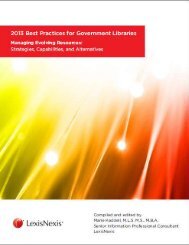2012 Best Practices for Government Libraries
2012 Best Practices for Government Libraries
2012 Best Practices for Government Libraries
Create successful ePaper yourself
Turn your PDF publications into a flip-book with our unique Google optimized e-Paper software.
Beyond news and business content, LexisNexis has a<br />
comprehensive collection of patent data from more<br />
than 100 patent authorities—31 in full text—available<br />
via its TotalPatent ® service. LexisNexis also lets<br />
you search more than 135 million federal and state<br />
court dockets simultaneously. And you can access 8<br />
million court documents, including 1.2 million briefs,<br />
pleadings, and motions. Also, with more than 35 billion<br />
documents, LexisNexis has one of the world’s largest<br />
online collections of public records. You can access 7.9<br />
billion unique name/address combinations that map to<br />
approximately 591 million unique identities; more than<br />
1.2 billion business records and 2 billion business contact<br />
records, representing more than 352 million unique<br />
businesses and more than 1.2 billion unique contacts;<br />
deed, mortgage, and tax assessor records; and more.<br />
In addition to data from publicly available sources, the<br />
LexisNexis Public Records repository includes regulated<br />
data, private data, and derived in<strong>for</strong>mation that are not<br />
readily available from other providers.<br />
LexisNexis delivers all this multi-source data in<br />
consistent <strong>for</strong>mats, and provides well-defined<br />
application interfaces to simplify integration. And unlike<br />
other third-party data providers that “self report”<br />
and rely solely on a single source <strong>for</strong> data validation,<br />
LexisNexis has multiple sources of the same data, thus<br />
enhancing its accuracy and credibility.<br />
Validating Big Data<br />
Use of data aggregated from such a wide variety of<br />
trusted sources enables an organization to corroborate<br />
its existing big data <strong>for</strong> more in<strong>for</strong>med decision making.<br />
Consider the following examples:<br />
• Suppose you are thinking about doing business with a<br />
specific firm. You want to understand as much as you<br />
can about that company—including potential risks—<br />
so you have amassed a wealth of in<strong>for</strong>mation on its<br />
executives, policies and procedures, business practices,<br />
etc. LexisNexis data helps broaden your perspective,<br />
not only helping you validate your assumptions based<br />
on the business intelligence you have gleaned from<br />
your data sources, but filling in gaps with additional<br />
in<strong>for</strong>mation and perhaps even highlighting differences<br />
that need to be explored. With access to consolidated<br />
news, business, legal, and patent records, you might<br />
find an abstract on the CEO that contains relevant data,<br />
rather than simply his or her corporate background; you<br />
may discover that there is pending litigation against the<br />
company; or you may learn that some of the company’s<br />
patents are about to expire.<br />
• Say you are working at a government agency related to<br />
national security or defense, and you are purchasing<br />
microchips from an overseas supplier. Because<br />
technology exists by which data can be transmitted<br />
over those microchips to unfriendly nations, you<br />
want to fully vet the supplier. Given the complexity of<br />
linkages across the global supply chain, you need to<br />
be fully aware of the interrelationships of your supplier<br />
with its various subcontractors. By complementing<br />
your internal data with aggregated news and business<br />
content from LexisNexis, you may find a reference<br />
in a small news abstract linking the supplier to an<br />
organization or individual in an embargoed or watchlisted<br />
country. Now you are aware of potential risks to<br />
the integrity of your supply chain.<br />
• Picture working <strong>for</strong> a state in which tax refund fraud<br />
is on the rise. By supplementing your data with data<br />
from the LexisNexis Public Records repository, you<br />
gain access to billions of public records sources and<br />
can thus establish identity-based filters to develop a<br />
comprehensive picture of each taxpayer’s identity. Now<br />
you can more easily flag suspicious refund requests by<br />
using these identity-based filters to uncover situations<br />
such as Social Security numbers altered to elude “Do<br />
Not Pay” lists; people using credentials of deceased<br />
individuals; individuals incarcerated in prison; or<br />
individuals not associated with their given addresses.<br />
• Imagine you are part of an urban planning initiative. By<br />
adding LexisNexis data to the data you have already<br />
collected, you can expand your view and validate the<br />
in<strong>for</strong>mation you have on demographics, spending<br />
patterns, census tract boundary files, topographical<br />
maps, land ownership records—all of which you need <strong>for</strong><br />
smarter infrastructure development and transportation<br />
planning, and thus smarter spending.<br />
For corporations and government agencies alike, the<br />
addition of the vast collection of credible, attributable,<br />
relevant data from LexisNexis allows <strong>for</strong> more precise<br />
modeling and deeper analytics <strong>for</strong> a greater return on<br />
investment in big data technology.<br />
Leveraging Your Big Data Technology Investment



